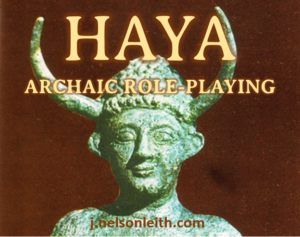![]() The following system-neutral, tabletop RPG setting is offered under an Attribution – No Derivatives Creative Commons license. The images used here for ambiance are under various other licensing regimes, except those specifically marked as original, so please do not include them if you copy this document.
The following system-neutral, tabletop RPG setting is offered under an Attribution – No Derivatives Creative Commons license. The images used here for ambiance are under various other licensing regimes, except those specifically marked as original, so please do not include them if you copy this document.
Contents

Original graphic.
Archaisms and Overview – The glacial north, the desert south, and the civilized realms on the seas between.
The Three Worlds and the Elements – The material, spiritual, and divine planes and how they interact through the eight elements.
Chronicle Stones – Magical slabs of rock that present books, either by shifting symbols on their surface or by speaking.
Classes – The key adventuring professions of Haya, aligned to their d20 System classes for easier gameplay.
Warriors (fighters) – These range from plate-armored Bronze Age soldiers in formation and individual champions to Stone Age braves.
Trackers (rangers) – The primary warriors of Stone Age hunter-gatherers, and those among farming peoples who have trained to wander the wilderness.
Hunters (barbarians) – Only available to the demihumans of the far north.
Rogues (rogues) – These sneaky types thrive in urban areas and on the high seas.
Poets (bards) – The songsters of the archaic world, with skills of charm and intrigue.
Traders (homebrew) – A class combining the urban street-wisdom of Rogues, the worldly lore of Trackers, the charm of Poets, and the knowledge of Scribes.
Scribes (wizards) – These are the scholars of Haya, using chronicle stones to study their world and wield magic.
Shaman (sorcerors) – The magical elite among Stone Age tribes, their power is inherited or gained from a traumatic event.
Priests (clerics) – Devotees to the gods, and leaders among their peoples.
Elders (druids) – The holy class among the Asnam people.
Races – The human and demihuman races of Haya, including cultural details and which classes are available to each.
True People (Humans) – Overviews of the PC races: the Yuta or Tower People, the Adya or Boat People, Agtile or South People, Entihoma or East People, Damdilit or High People, and the Zitan or Cavern People.
Outer People (Demihumans and Quasihumans) – Overviews of the NPC races: the Himhet Red-Hairs and Sebilos Stone-Hairs, who are like the Neanderthals and Denisovans, the Otovyi Wood People and Janis Dust People, who are like Homo erectus/ergaster, and those whom some consider among the True People: the tall, forest-dwelling Asnam or Gold-Hairs; the short, hill-dwelling Razu or Old People; and the short, jungle-dwelling Tsote, called the Flower People for their multi-colored hair.
Under People (Humanoids) – Overviews of the monster races: the Ohti or Northern Giants, strongly built hominids like Home erectus driven to gigantism by isolation; the Ezolites or Southern Giants, a Neanderthal-like race in the deserts of the Agtile; the White, Black, and Red Peyu, or Ice, Mountain, and Valley Giants who are like Gigantopithecus; the Matamhi Forest People who are like evolved orangutans; and the Zhydh Toothed People who are like feralized Neanderthals.
Monsters – The creatures of Haya, including prehistoric animals, Spirit Folk, and mythological beasts.
Time – How the hours, days, weeks, years, and great-years of Haya are tied to the elements, and how this affects elemental magic.
World – The different regions of Haya described in reference to the peoples who live there. What players can expect as they journey through the game world, the cultures and perils and opportunities for adventure.
History – The important events in the history of Haya, providing background for adventure and exploration.
Items – The fun stuff the players can expect to find and use in the game world. Cool things like chronicle stones, ancient relics, and unique weapons.
Magic – How the magic of Haya plays out in spells and magic items.
Prologue
The Scribe’s fingers played across the chronicle stone. His student sat on his knees on the triple mat. The sound of military log-drums and conch horns hammered at the boy’s concentration. His older brother was out there, in formation, in bronze plate holding a sword and pentagon shield. The invasion of Divesh would begin soon.
The Scribe raised his hand. “Are you prepared? Is your mind at pehgis (peace/calm)?”
The boy shook his head. “I am not ready for more spells.”
“No spells today,” the Scribe said. “We have a deeper lesson.”
The boy swallowed and turned his ear toward the martial music.
“Calm your mind,” the Scribe said with a musical cadence. “What are the Five Philosophical Questions?”
The boy nodded. “Are the Asnam among the True People? Where is the homeland of the True People? How old is the oldest chronicle stone? Are the gods real? How can people achieve pehgis?”
